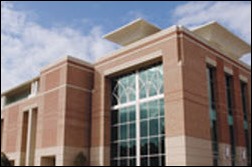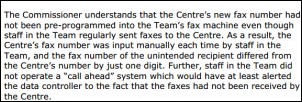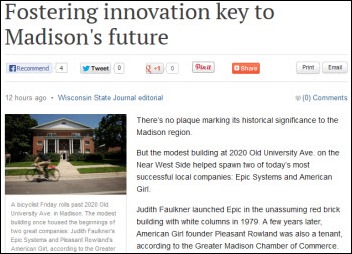Top News

The FDA urges medical device makers to protect their products against hackers and malware and offers guidance for developing security controls that would protect the confidentiality and integrity of data and limit malfunctions in the event of computer viruses.
Reader Comments

 From Biker Dude: “Re: HIStalk Practice. What do I win if I am your 500,000th visit?” Thanks for noticing that HIStalk Practice is about to hit a milestone in the next couple of weeks. No prize for making the visit counter hit 500,000, though every reader has my undying gratitude for the support.
From Biker Dude: “Re: HIStalk Practice. What do I win if I am your 500,000th visit?” Thanks for noticing that HIStalk Practice is about to hit a milestone in the next couple of weeks. No prize for making the visit counter hit 500,000, though every reader has my undying gratitude for the support.
 From Mojo: “Allscripts. I heard they are scheduling a conference call Friday to announce another reorg. Have you heard anything like this?” No, although another reader shared news that Allscripts had sold off its forms division (who knew they still had a forms division?) Unverified but neither piece of news would not be surprising given that CEO Paul Black has now had six months to get a lay of the land and the company reported a loss in Q1.
From Mojo: “Allscripts. I heard they are scheduling a conference call Friday to announce another reorg. Have you heard anything like this?” No, although another reader shared news that Allscripts had sold off its forms division (who knew they still had a forms division?) Unverified but neither piece of news would not be surprising given that CEO Paul Black has now had six months to get a lay of the land and the company reported a loss in Q1.
From Zee: “Re: inbox. I want to do a prototype on how we could improve the old-style physician inbox so that read-only information can be delivered in a meaningful way on a tablet. Replicating the current functionality as is isn’t innovation.” Sounds like a fun challenge to visualize how an improved inbox might work. Send me your ideas and I’ll run them here.
HIStalk Announcements and Requests
 HIStalk Practice highlights from the last week include: CMS pays out $547 million in PQRS and e-prescribing incentives in 2011. Physician compensation is increasingly tied to measures of quality and patient satisfaction. AHRQ offers a guide for primary care physicians connecting to RHIOs. As of the end of April, one out of two Medicare EPs were meaningful users of EHRs. MyMedicalRecords ends a lawsuit with Emdeon but initiates a new one with Jardogs. Emdeon CEO George Lazenby discusses his company, the industry, and potential opportunities. Rob Drewniak of Hayes Management Consulting looks at healthcare data governance and data stewardship. Thanks for reading.
HIStalk Practice highlights from the last week include: CMS pays out $547 million in PQRS and e-prescribing incentives in 2011. Physician compensation is increasingly tied to measures of quality and patient satisfaction. AHRQ offers a guide for primary care physicians connecting to RHIOs. As of the end of April, one out of two Medicare EPs were meaningful users of EHRs. MyMedicalRecords ends a lawsuit with Emdeon but initiates a new one with Jardogs. Emdeon CEO George Lazenby discusses his company, the industry, and potential opportunities. Rob Drewniak of Hayes Management Consulting looks at healthcare data governance and data stewardship. Thanks for reading.
On the Jobs Board: Compliance Program Manager, Software Engineer, Territory Sales Manager – South Eastern US.

Welcome to new HIStalk Platinum Sponsor Sagacious Consultants of Lenexa, KS. Sagacious means smart and having good judgment (I had to look it up), and the company applies those qualities to its singular focus: Epic. A full 97 percent of its employees came from Epic, collectively holding every Epic certification. The company has worked with 40 Epic hospitals and physician practices on full implementations, big bang installs, upgrades, and rollouts. It can provide build analysts, team leads, project managers, trainers, and go-live support. KLAS ranks it #1 in satisfaction for staffing and implementation support, with 100 percent of clients saying it keeps its promises and 100 percent saying they would hire the company again. Consultants work from their homes nationally, reducing travel billing and making them happier besides. Thanks to Sagacious Consultants for supporting my work.

The next HIStalk Webinar will be “Using Clinical Language Understanding & Infrastructure Planning as Key Strategies to Ensure Clinical Revenue Integrity with ICD-10” on Tuesday, June 25, 2013 from 1:00 – 1:45 Eastern time. It is sponsored by Nuance Healthcare and will be presented by Mel Tully MSN, CCDS, CDIP, senior vice president at J. A. Thomas and Associates. Register now.

A reader provides this photographic evidence of a pop-up HIStalk presence in Paris, as evidenced by a “I Could Be Mr H” banner in the shadow of the Eiffel Tower. Snap a picture with something HIStalk showing HIStalk in an interesting location and I’ll run it here.
Listening: new Black Sabbath, with “13” being the first new studio album since 1995 and the first with Ozzy in 35 years. I’ve listened to it at least 10 times and it’s a perfect 1970s sludge metal sound. It’s magnificent.
Acquisitions, Funding, Business, and Stock

Allscripts prices a private offering of $300 million aggregate principal amount of its cash convertible senior notes due 2020. The conversion price represents a 30 percent premium to June 12’s closing price of $13.22 per share.
Emdeon acquires Goold Health Systems, a provider of pharmacy benefits and related services to state Medicaid agencies.
Sales
Christus Health selects McKesson’s suite of documentation management solutions for integration with the health system’s existing HIS.

Swedish Covenant Hospital (IL) selects eClinicalWorks EHR and RCM solutions for its 150 employed physicians.
The DoD awards PSI and partners TechWerks and Mediware a $9.2 million follow-on task order to sustain and maintain the DoD’s enterprise blood management system.
People

 Aneesh Chopra, former US CTO and one of technology’s most beautiful men, loses his bid to be Virginia’s Democratic nominee for lieutenant governor.
Aneesh Chopra, former US CTO and one of technology’s most beautiful men, loses his bid to be Virginia’s Democratic nominee for lieutenant governor.

Quantros names Dmitri Daveynis (HP) SVP of engineering.

US Surgeon General Regina Benjamin announces her resignation after four years in the post. Benjamin does not provide specific details on her future plans, but Democratic Party officials have identified her as a potential candidate for a Congressional seat being vacated in her home state of Alabama.
Announcements and Implementations
Healthix and the Brooklyn Health Information Exchange will merge into a single RHIO and retain the name Healthix. A new board of directors will govern the entity and leadership and staff from both RHIOs will continue to support the organization.
Salford Royal NHS Foundation Trust implements Allscripts Sunrise Clinical Manager three months ahead of schedule and on budget.
KershawHealth (SC) implements a paperless clinical data bridge solution from Access to transfer EKG traces and other clinical data into its EHR.

Marshfield Clinic (WI) will form Marshfield Clinic Information Services, a separate for-profit subsidiary that will support the clinic and technology and services to other customers. The clinic’s 350 IS employees will join the new entity.
IBM, the Premier healthcare alliance, and four healthcare systems launch the Data Alliance Cooperative, which will allow members to share experiences and co-develop solutions that integrate data across the care continuum. Initial focus will be on reducing medication non-compliance and readmissions through predictive modeling.
Innovation and Research

Interested in Google Glass? Kyle, who writes for HIStalk Connect, is part of Pristine, a startup that’s developing Glass apps for physicians. He has received his pair and invites readers to give them a try at a party in New York City on Thursday, June 20 from 6 to 9 p.m. at Galway Pub. E-mail Kyle to RSVP and bring friends if you like.
Technology

Nuance releases a new version of Dragon Medical Practice designed for smaller practices that includes voice shortcuts to aid searches for medical information and more than 90 specialized medical vocabularies.
Other

Care Logistics sues Ohio-based Catholic Health Partners of Cincinnati and Mercy Health Systems of Toledo, claiming it has lost $50 million after the health systems reneged on a 2008 deal to serve as reference sites for the company’s bed management software in return for royalties.
Inga is so proud of beating Weird News Andy to this story. A trucker sues a urologist for what he claims was a botched penile implant that caused him to have an erection for eight months. The doctor says the man should have told him when his scrotum swelled to volleyball size, but the man says he was told to expect swelling. The patient, who changed his wardrobe to baggy sweatpants and long shirts, made his case to the jury: “I could hardly dance, with an erection poking my partner … It’s not something you want to bring out at parties and show to friends.”
Sponsor Updates
- CollaborateMD will add educational content from Elsevier into its ClaimGear solution for medical billing and coding education.
- NoMoreClipboard will integrate ICA’s HIE offerings with its PHR and patient portal.
- Vitera Healthcare releases Vitera Medical Manager EHR, a Web-based EHR, analytics, and transaction platform for its customers.
- Ingenious Med integrates Wolters Kluwer Health’s Health Language code search engine into its point-of-care charge capture solution.
- Impact Advisors Principal John Stanley discusses analytics as it relates to HIE.
- Emdat publishes a case study highlighting Illinois Bone and Joint Institute, which reduced its documentation costs by 50 percent after implementing Emdat’s medical documentation platform.
- Porter Research discusses the role of NLP technology in healthcare transformation with Nuance CMIO Nick van Terheyden.
- Perceptive Software CTO Brian Anderson offers five predictions for business process management, enterprise content management, and capture and search.
- The office manager for Summersville Pediatrics (SC) shares her practice’s experience migrating from MyWay to Aprima.
- PeriGen publishes a case study featuring Summit Healthcare’s (AZ) experience of implementing advanced perinatal technology.
- David Laureau, CEO of Medicomp Systems, discusses the importance of giving providers the data required to better manage the health of individual patients in real time and at the point of care.
- VitalWare’s VP of Compliance Jill Wolf will discuss the benefits and limitations of predictive modeling at next week’s HIMSS ICD-10 Forum Washington, DC.
- Wolters Kluwer Health’s customer advisory board says that improving clinical outcomes through expanded integration of clinical decision support is a top priority.
- iSirona will remain in Panama City, FL after the county and state promise $1.8 million in incentives. The company will 300 new jobs in the next three years.
EPtalk by Dr. Jayne
The United States Supreme Court ruled this week on Oxford Health Plans v. Sutter. Essentially this paves the way for physicians to use class arbitration to resolve issues with payers. Dr. Sutter, a pediatrician, alleged that Oxford systematically bundled, downcoded, and delayed patients for more than 20,000 network physicians but Oxford claimed physicians had to participate in arbitration as individuals. The case has been in the courts for more than a decade. I like to see the little guy stick it to the payer at least once in a while.
Medicare will be issuing a redesigned Medical Summary Notice to beneficiaries. Aimed at preventing fraud and abuse, it will show the services and supplies billed to Medicare during the past three months, the amount paid, and the patient responsible portion.
I’d like to see all payers take this approach. I’m still getting Explanation of Benefits statements from a procedure last year that the practice erroneously billed yet keeps trying to hit me up for the insurance balance. Guess what, not paying it. And to my orthopedic surgeon – guess what, you’re going to be refunding me all the co-pays you’re making me pay for follow-ups in the global period. Dr. Jayne has her summary plan description and knows how to read it. And if you cross me, I might just demand an electronic copy of my record, which I know will cause much consternation in your office. Welcome to the era of patient empowerment.
Athenahealth offers an ICD-10 Guarantee for practices that are live by June 30, 2014. Additionally, practices experiencing cash flow disruptions may be eligible for cash advances against outstanding claims. There’s a fair amount of fine print involved, but I like the idea.
Apple announced this week that the next generation of its mobile operating system will contain a virtual “kill switch,” or activation lock to allow stolen devices to be deactivated.
A couple of my friends convinced me to sit for the Clinical Informatics subspecialty certification from the American Board of Preventive Medicine. In reading through the various requirements I have one major concern (other than the cost of the exam, which is substantial). The criteria require current certification by one of the other ABMS specialty boards. This is problematic for informaticists who have let their clinical certifications lapse. I understand why they’re doing it, but the thought of maintaining two certifications isn’t a happy one. I’d be interested to hear from others who are planning to take the exam.

E-mail Dr. Jayne.
Contacts
Mr. H, Inga, Dr. Jayne, Dr. Gregg, Lt. Dan, Dr. Travis.
More news: HIStalk Practice, HIStalk Connect.































































Merry Christmas and a Happy New Year to the HIStalk crowd. I wish you the joys of the season!